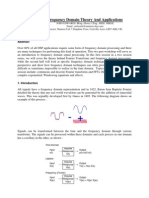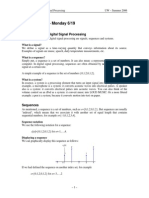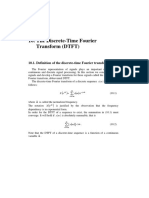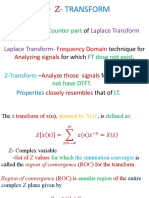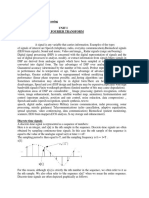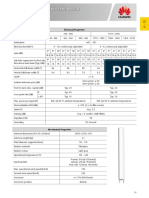0 ratings0% found this document useful (0 votes)
166 views00 Course Introduction Signal & System
This document outlines the course objectives, learning outcomes, content, schedule, instructor, and assessment methods for ECE 2221 Signals and Systems. The course aims to provide analysis skills for continuous-time signals and systems in both time and frequency domains. Over 8 weeks, topics will include time-domain analysis, Laplace transforms, Fourier series, Fourier transforms, and sampling. Assessment includes quizzes, assignments, a midterm exam, and a final exam. The instructor is Ahmad Zamani Jusoh and students are encouraged to contact him for support.
Uploaded by
Muhammad AzwirCopyright
© © All Rights Reserved
Available Formats
Download as PPT, PDF, TXT or read online on Scribd
0 ratings0% found this document useful (0 votes)
166 views00 Course Introduction Signal & System
This document outlines the course objectives, learning outcomes, content, schedule, instructor, and assessment methods for ECE 2221 Signals and Systems. The course aims to provide analysis skills for continuous-time signals and systems in both time and frequency domains. Over 8 weeks, topics will include time-domain analysis, Laplace transforms, Fourier series, Fourier transforms, and sampling. Assessment includes quizzes, assignments, a midterm exam, and a final exam. The instructor is Ahmad Zamani Jusoh and students are encouraged to contact him for support.
Uploaded by
Muhammad AzwirCopyright
© © All Rights Reserved
Available Formats
Download as PPT, PDF, TXT or read online on Scribd
You are on page 1/ 14
ECE 2221
SIGNALS AND SYSTEMS
ECE 2221 Signals and Systems
1
Ahmad Zamani Jusoh
Outline
Course Objectives
Learning Outcomes
Course Synopsis
Text and Supporting Books
Course Instructor, Contact Info, Schedule
Assessment and Previous Data
Ahmad Zamani Jusoh
ECE 2221 Signals and Systems
2
Course Objectives
Ahmad Zamani Jusoh
ECE 2221 Signals and Systems
3
To provide an analysis skill of the continuous-time signals
and systems as reflected to their roles in engineering
practice.
To expose students to both the time-domain and
frequency-domain methods of analyzing signals and
systems.
To illustrate the potential applications of this course as a
pre-requisite course to communication engineering and
principles, digital signal processing and control system.
OBE (Outcome Based Education)
Learning Outcomes
Ahmad Zamani Jusoh
ECE 2221 Signals and Systems
4
Classify and characterize signals and systems.
Analyze continuous-time signals and systems in time domain using
convolution.
Analyze continuous-time signals and systems in frequency domain
using Laplace transform.
Analyze the spectrum of continuous-time signals and systems
using Fourier series and Fourier transform.
Apply signals and systems analysis in communication systems,
control systems and digital signal processing.
Upon completion of this course, students should be able to:
Course Synopsis
Ahmad Zamani Jusoh
ECE 2221 Signals and Systems
5
Introduction to Signals and Systems (1 week)
Time-Domain Analysis of Continuous-Time Systems (1 week)
Frequency-Domain System Analysis: the Laplace Transform (1 week)
MID-TERM Examination
Signals Analysis using the Fourier Series (1 week)
Signals Analysis using the Fourier Transform (1 week)
Introduction to Discrete Time Signals and Systems Analysis (1 week)
FINAL Examination
Text Book and Recommended Books
Ahmad Zamani Jusoh
ECE 2221 Signals and Systems
6
Required:
Lathi BP. (2010), Linear Systems and Signals, Oxford.
Recommended:
Lathi BP. (2000), Signal Processing and Linear Systems, Oxford.
Oppenheim (1996), Signals and Systems , Prentice-Hall.
Hsu H (1995), Schaums Outlines Signals and Systems 2
nd
Edition,
McGrawHill.
Haykin S (2002), Signals and Systems, John-Wiley.
A.J. Stuller (2008). An Introduction to Signals and Systems, Thomson.
Karu Z (1995), Signals and Systems Made Ridiculously Simple, McGrawHill.
New Books with MATLAB
Ahmad Zamani Jusoh
ECE 2221 Signals and Systems
7
Content outline of the course / module and the SLT per topic
Dr. Sigit PW Jarot
ECE 2221 Signals and Systems
8
Content outline of the course / module and the SLT per topic
Weeks Topics
Learning
Hours
Task/
Reading
1
Introduction to Signals and Systems
Size of a Signal, Some Useful Signal Operations, Classification of Signals,
Some Useful Signal Models, Even and Odd Functions, Classification of
Systems, System Model: Input-Output Description, Introduction to Matlab
for Signals and Systems
6 Chapter 1
2,3
Time-Domain Analysis of Continuous-Time Systems
System response to Internal Conditions, The Unit Impulse Response,
System Behavior to External Input, The Convolution Integral, Interconnected
Systems, System Stability, Intuitive Insight into System Behavior
9 Chapter 2
3,4
Frequency-Domain System Analysis: the Laplace Transform
The Laplace Transform and the Inverse Laplace Transform, Some
Properties of the Laplace Transform, Solution of Differential and Integro-
Differential Equations, Block Diagrams, The Bilateral Laplace Transform
9 Chapter 4
5
Signals Analysis using the Fourier Series
Periodic Signal Representation by Trigonometric Fourier Series, Existence
and Convergence of the Fourier Series, Exponential Fourier Series, LTI
System Response to Periodic Inputs, Generalized Fourier Series
6 Chapter 6
6,7
Signals Analysis using the Fourier Transform
Aperiodic Signal Representation by Fourier Integral, Some Properties of the
Fourier Transform, Ideal and Practical Filters, Signal Energy, Application to
Communication
9 Chapter 7
7
Sampling: The Bridge from Continuous to Discrete: The Sampling
Theorem, Signal Reconstruction, Spectral Sampling, DFT and FFT
3 Chapter 8
Student Learning Time
ECE 2221 Signals and Systems
9
Face to Face Assessments
I
n
d
e
p
e
n
d
e
n
t
L
e
a
r
n
i
n
g
Total
Student
Learning
Time
L
e
c
t
u
r
e
T
u
t
o
r
i
a
l
D
i
s
c
u
s
s
i
o
n
C
o
n
t
i
n
u
o
u
s
A
s
s
e
s
s
m
e
n
t
F
i
n
a
l
34 13 8 2 3 65 125
Ahmad Zamani Jusoh
Course Instructor
Ahmad Zamani Jusoh
ECE 2221 Signals and Systems
10
Name : Ahmad Zamani Jusoh
Email : azamani@iium.edu.my Ext: 4468
Office : E1-2.13.9
Methods of Assessment
Ahmad Zamani Jusoh
ECE 2221 Signals and Systems
11
Quizzes
15%
Assignments
10%
Mid-term Exam
25%
Final Exam
50%
Assessment
Methods of Assessment
Ahmad Zamani Jusoh
ECE 2221 Signals and Systems
12
small check points
usually once per topic
by default without pre-announcement
exposure of basic problems exercises
exposure of simulation exercises
once per chapter
cooperation is highly encouraged
a major check point
once per semester
good chance to obtain high CAM
the last check point & positioning
80% of course outline
60-70% after midterm
30-40-30% distribution;
30% easy: general concept
40% moderate: relevant topics
30% difficult: in-depth & critical
Marks Distributions
Ahmad Zamani Jusoh
ECE 2221 Signals and Systems
13
Inspiring Message from Imam Shafii
Ahmad Zamani Jusoh
ECE 2221 Signals and Systems
14
Intelligence
Strong Will
Diligence
Patience
Sufficient Means
Befriend Your Teacher
You will not acquire knowledge unless you have 6 (SIX) THINGS
You might also like
- Advanced Topics in Digital Signal ProcessingNo ratings yetAdvanced Topics in Digital Signal Processing23 pages
- Transmission Lines in Digital and Analog Electronic Systems: Signal Integrity and CrosstalkFrom EverandTransmission Lines in Digital and Analog Electronic Systems: Signal Integrity and CrosstalkNo ratings yet
- Signal Representation Using Fourier SeriesNo ratings yetSignal Representation Using Fourier Series17 pages
- Cross-Correlation and Auto - CorrelationNo ratings yetCross-Correlation and Auto - Correlation6 pages
- Advanced Digital Signal Processing Lecture 10% (1)Advanced Digital Signal Processing Lecture 142 pages
- Fourier Analysis: Synthesis. For Example, Determining WhatNo ratings yetFourier Analysis: Synthesis. For Example, Determining What11 pages
- Digital Signal Processing R13 Previous Papers100% (1)Digital Signal Processing R13 Previous Papers5 pages
- Signal: Continuous-Time Signal: Defined in A Continuous Range of TimeNo ratings yetSignal: Continuous-Time Signal: Defined in A Continuous Range of Time8 pages
- Basis Functions (3 Lectures) : Concept of Basis Functions. Fourier Transform and Its PropertiesNo ratings yetBasis Functions (3 Lectures) : Concept of Basis Functions. Fourier Transform and Its Properties16 pages
- Transform: of Technique For For Which - For Which That ofNo ratings yetTransform: of Technique For For Which - For Which That of119 pages
- Signal and System Alan V. Oppenheim Notes of ch1No ratings yetSignal and System Alan V. Oppenheim Notes of ch19 pages
- Course Objective: Wollo University Kombolcha Institute of Technology Department of Electrical and Computer EngineeringNo ratings yetCourse Objective: Wollo University Kombolcha Institute of Technology Department of Electrical and Computer Engineering2 pages
- Time To Renew Our Love Affairs With Public LibrariNo ratings yetTime To Renew Our Love Affairs With Public Librari2 pages
- Service Manual: DR4050/ Compact Disc RecooderNo ratings yetService Manual: DR4050/ Compact Disc Recooder64 pages
- A Transformer-Based OFDM Receiver For Underwater Acoustic CommunicationNo ratings yetA Transformer-Based OFDM Receiver For Underwater Acoustic Communication5 pages
- Headphone Measurements Using Brüel & Kjær 5128 HATS _ Audio ScieNo ratings yetHeadphone Measurements Using Brüel & Kjær 5128 HATS _ Audio Scie23 pages
- SAR With Digital Beamforming On Receive Only: Manvan - Younis@etec - Uni-Karlsruhe - deNo ratings yetSAR With Digital Beamforming On Receive Only: Manvan - Younis@etec - Uni-Karlsruhe - de3 pages
- Wireless Communication and Mobile ComputingNo ratings yetWireless Communication and Mobile Computing64 pages
- MULTIPLE CHOICE. Choose The One Alternative That Best Completes The Statement or Answers The QuestionNo ratings yetMULTIPLE CHOICE. Choose The One Alternative That Best Completes The Statement or Answers The Question4 pages
- Network Core: Circuit Switching: End - End Resources Reserved For "Call"No ratings yetNetwork Core: Circuit Switching: End - End Resources Reserved For "Call"20 pages
- 1. Reja 03.2 Image Processing - Frequency Analysis1No ratings yet1. Reja 03.2 Image Processing - Frequency Analysis142 pages
- Part-A Experiments Using Matlab: DSP Lab ManualNo ratings yetPart-A Experiments Using Matlab: DSP Lab Manual40 pages
- Microwave and Millimeter Wave Power BeamingNo ratings yetMicrowave and Millimeter Wave Power Beaming31 pages
- Tides: Output Modes Audio Rate OperationNo ratings yetTides: Output Modes Audio Rate Operation2 pages
- Gyraf Audio's Obscure Schematics: Mic PreampsNo ratings yetGyraf Audio's Obscure Schematics: Mic Preamps6 pages
- Transmission Lines in Digital and Analog Electronic Systems: Signal Integrity and CrosstalkFrom EverandTransmission Lines in Digital and Analog Electronic Systems: Signal Integrity and Crosstalk
- Fourier Analysis: Synthesis. For Example, Determining WhatFourier Analysis: Synthesis. For Example, Determining What
- Signal: Continuous-Time Signal: Defined in A Continuous Range of TimeSignal: Continuous-Time Signal: Defined in A Continuous Range of Time
- Basis Functions (3 Lectures) : Concept of Basis Functions. Fourier Transform and Its PropertiesBasis Functions (3 Lectures) : Concept of Basis Functions. Fourier Transform and Its Properties
- Transform: of Technique For For Which - For Which That ofTransform: of Technique For For Which - For Which That of
- Course Objective: Wollo University Kombolcha Institute of Technology Department of Electrical and Computer EngineeringCourse Objective: Wollo University Kombolcha Institute of Technology Department of Electrical and Computer Engineering
- Time To Renew Our Love Affairs With Public LibrariTime To Renew Our Love Affairs With Public Librari
- A Transformer-Based OFDM Receiver For Underwater Acoustic CommunicationA Transformer-Based OFDM Receiver For Underwater Acoustic Communication
- Headphone Measurements Using Brüel & Kjær 5128 HATS _ Audio ScieHeadphone Measurements Using Brüel & Kjær 5128 HATS _ Audio Scie
- SAR With Digital Beamforming On Receive Only: Manvan - Younis@etec - Uni-Karlsruhe - deSAR With Digital Beamforming On Receive Only: Manvan - Younis@etec - Uni-Karlsruhe - de
- MULTIPLE CHOICE. Choose The One Alternative That Best Completes The Statement or Answers The QuestionMULTIPLE CHOICE. Choose The One Alternative That Best Completes The Statement or Answers The Question
- Network Core: Circuit Switching: End - End Resources Reserved For "Call"Network Core: Circuit Switching: End - End Resources Reserved For "Call"
- 1. Reja 03.2 Image Processing - Frequency Analysis11. Reja 03.2 Image Processing - Frequency Analysis1














